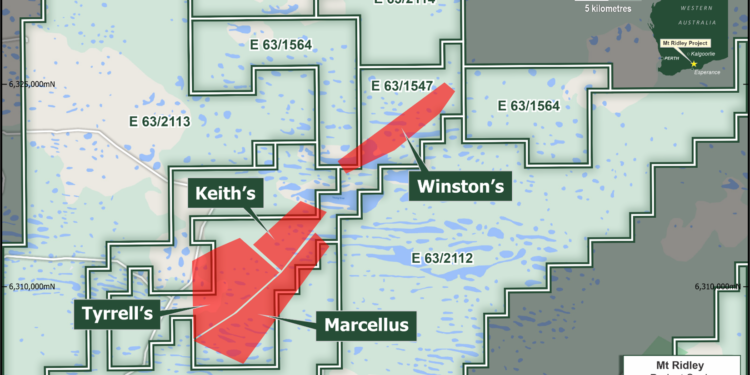Mount Ridley Mines Limited (ASX: MRD) has commenced Stage 1 – Primary Target Infill Drilling at the Mt Ridley Rare Earth Project in Western Australia, targeting ionic adsorption clay-styled rare earth element (REE) mineralisation at the high priority Winston’s Prospect.
Chairman. Peter Christie, said this will be followed by a substantial Stage 2 “Regional” 1,000-hole aircore programme, along an existing network of tracks within a 750 sq. km (approximately 40km x 20km) area, over the next five months.
Results will be used to outline the potential scale of the project and to rank areas of REE mineralisation for more detailed evaluation
“It’s an exciting time for the company as the first rare earth element-specific drilling gets going at our Mt Ridley project, expanding on the excellent assay results reported to date,” Mr Christie said.
“The Mt Ridley team has done some excellent work in completing a detailed Heritage Management Plan and Programs of Work submissions in preparation for this drilling campaign.
“The company is well funded and has committed to rapidly exploring the project for rare earth elements through substantial but judicious drilling programs executed in a staged approach. The aim of the drilling stages proposed is to outline a rare earth element project of significant scale.”
Mount Ridley has implemented a four-stage drilling program aimed at determining the overall extent of mineralisation within the large, 3,400 sq. km Mount Ridley Rare Earth Project including various prospects that were previously drilled between 2014-2016.
The project is situated approximately 35 kilometres northeast of the deep-water port of Esperance in Western Australia’s south. The near-term objective is to steadily advance high priority areas to enable the estimation of a JORC 2012 compliant maiden mineral resource estimate later in the year.
The drill programme is designed to avoid agricultural land, utilise existing cleared tracks where possible and avoid areas where Proterozoic-aged inselbergs and ridges protrude through the Eocene-aged Bremmer Basin creating areas unlikely to host significant REE mineralisation.
2022 Drilling Programme
Stage 1 – Primary Target Infill Drilling: Now underway at the high priority Winston’s Prospect, aircore holes are being completed on a 400 x 200m grid. The holes identifying REE mineralisation will later be infilled to 200 x 200m pattern and include a provision for core drilling to provide samples for advanced metallurgy and other inputs required for Mineral Resource estimations.
Stage 2 – Regional: Using the existing network of tracks, grids and firebreaks, traverses of aircore drilling will be completed with wide spaced reconnaissance holes spaced at 400 or 800 apart, to quickly map the extent of Bremmer Basin REE mineralisation and any higher-grade internal zones, including the grade of total rare earth oxides (TREO) (and particularly critical rare earth oxide (CREO), recovery and depth of cover. A Program of Work (PoW) with provision for 950 aircore holes has already been approved for Stage 2 work.
Stage 3 – Primary Target Expansion: Drilling the flanks of defined mineralisation, such as Winston’s and Keith’s, for extensions. The Company has in place a Heritage Management Plan and is preparing a Clearing Permit covering an area of 18km x 10km (180 sq. km) to enable this work. Many existing drilling intersections from within the perimeter of this expansion programme returned REE mineralisation thicknesses exceeding 10m, which require follow-up drilling.
Stage 4 – Resource drill out: Comparable projects (i.e., simply layered ionic clay-hosted REE deposits) have been drilled out on a 200 x 200m pattern which may enable JORC 2012 compliant Indicated Mineral Resources to be estimated. However, the final drill hole density required to do this will be determined by an independent geological expert and will be based on a combination of the historical results and the results of Stages 1 to 3.
For further information please visit: https://mtridleymines.com.au/












